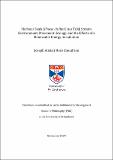Files in this item
Harbour seals (Phoca vitulina) in a tidal stream environment : movement ecology and the effects of a renewable energy installation
Item metadata
| dc.contributor.advisor | Hastie, Gordon Drummond | |
| dc.contributor.advisor | Thompson, David | |
| dc.contributor.author | Onoufriou, Joseph | |
| dc.coverage.spatial | xv, 258 p. | en_US |
| dc.date.accessioned | 2021-06-29T16:04:10Z | |
| dc.date.available | 2021-06-29T16:04:10Z | |
| dc.date.issued | 2020-07-29 | |
| dc.identifier.uri | https://hdl.handle.net/10023/23447 | |
| dc.description.abstract | Despite ever increasing information on the importance of oceanographic processes for marine predators, movement ecology of higher trophic level species in tidal stream environments remains relatively under-studied. This represents a significant knowledge gap for certain species which spend large portions of their lives in these energetic habitats. In this thesis I show that a top predator, the harbour seal (Phoca vitulina), inhabiting one of the most tidally energetic regions in Europe, the Pentland Firth, shows a complex range of behaviours as a consequence of the strong current flows they are subjected to. Both horizontal movement and diving behaviour elucidate a degree of foraging plasticity, hitherto undocumented in a single population of harbour seals. I also demonstrate that, by using multiple perspectives of movement, researchers can better tease apart ecologically important areas for animals inhabiting these habitats. Given the importance of tidally energetic systems for harbour seals, I then go on to study the impact of tidal energy installations on their movements and physical fitness. Using telemetry data, I determine an overt avoidance response of the local population to an operational turbine array and demonstrate the effect this can have on our understanding of collision risk. To further augment our predictions of the population level effect of these devices, I then go on to demonstrate that not all collisions between seals and tidal turbine blades are likely to result in fatality. In combination, these results suggest that currently held views on the lethal effects of tidal turbines are overly-conservative, and the likely behavioural and physical responses to these devices may result in a more ecologically favourable outcome than previously assumed. | en_US |
| dc.description.sponsorship | "This PhD was funded by co-funded by Scottish Natural Heritage (SNH), Marine Scotland (project reference MMSS/002/15) and the Marine Alliance for Science and Technology (MASTS; grant reference HR09011)." -- Acknowledgements | en |
| dc.language.iso | en | en_US |
| dc.publisher | University of St Andrews | |
| dc.subject | Phocid | en_US |
| dc.subject | Movement ecology | en_US |
| dc.subject | Renewable energy | en_US |
| dc.subject | Spatial ecology | en_US |
| dc.title | Harbour seals (Phoca vitulina) in a tidal stream environment : movement ecology and the effects of a renewable energy installation | en_US |
| dc.type | Thesis | en_US |
| dc.contributor.sponsor | Scottish Natural Heritage (SNH) | en_US |
| dc.contributor.sponsor | Scotland. Marine Scotland | en_US |
| dc.contributor.sponsor | Marine Alliance for Science and Technology for Scotland (MASTS) | en_US |
| dc.type.qualificationlevel | Doctoral | en_US |
| dc.type.qualificationname | PhD Doctor of Philosophy | en_US |
| dc.publisher.institution | The University of St Andrews | en_US |
| dc.identifier.doi | https://doi.org/10.17630/sta/85 |
This item appears in the following Collection(s)
Items in the St Andrews Research Repository are protected by copyright, with all rights reserved, unless otherwise indicated.

